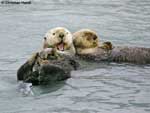The sea otter (Enhydra lutris) is a  diurnal marine species geographically distributed throughout the western coast of the United States and Canada, the islands off the coast of Alaska, Japan, and the eastern coast of Russia (Estes, 1980; Nowak, 1991). Sea otters are just over one meter in length, with a tail length ranging from 25 cm to 37 cm. Males weigh between 22 kg and 45 kg and females weigh between 15 kg and 32 kg. Sea otters are variable in color, ranging from reddish brown to dark brown to black, and the head, throat and chest are white. The species is specialized for swimming and has flattened and webbed hind paws (Nowak, 1991).
diurnal marine species geographically distributed throughout the western coast of the United States and Canada, the islands off the coast of Alaska, Japan, and the eastern coast of Russia (Estes, 1980; Nowak, 1991). Sea otters are just over one meter in length, with a tail length ranging from 25 cm to 37 cm. Males weigh between 22 kg and 45 kg and females weigh between 15 kg and 32 kg. Sea otters are variable in color, ranging from reddish brown to dark brown to black, and the head, throat and chest are white. The species is specialized for swimming and has flattened and webbed hind paws (Nowak, 1991).
Sea otters belong to the group Mustelidae, which includes 23 genera and 65 species comprising otters, weasels, badgers, and skunks (Nowak, 1991). The sea otter is the largest species within Mustelidae (Estes, 1980). There are four genera of otters including the river otter (Lutra), the giant otter (Pteronura), the clawless otter (Aonyx), and the sea otter (Enhydra). Enhydra is monospecific (Nowak, 1991).
Sea otters spend the majority of their life in the ocean, thus they are classified as marine mammals. The species eats in the water, often using its chest to hold its food, and rests on rocks near the water’s edge (Estes, 1980; Nowak, 1991). Unlike other marine mammals, sea otters do not have an insulating layer of fat to retain heat. Instead, they have an incredibly thick layer of fur that traps air in order to maintain body temperature. In fact, sea otters have the densest fur of all mammals! This system of thermoregulation does not function well if water is polluted. If the fur of a sea otter becomes damaged by an oil spill, the fur is incapable of trapping air (Nowak, 1991).
The diet of sea otters includes fish and many marine invertebrates, including sea urchins (e.g., Strongylocentrotus purpuratus), mollusks, abalones, and crustaceans (Estes, 1980; Nowak, 1991). Sea otters require a large quantity of food and eat between 25% and 30% of their body weight every day! Sea otters have also been documented to use tools. In order to break open a hard shell, an individual places the food item on its chest and uses a rock to break it open (Nowak, 1991). Sea otters obtain the majority of their water from food, but they also drink seawater (Estes, 1980).
Individuals typically remain solitary, however groups are often formed while resting. Males and females have distinct territories that are not necessarily in close proximity. Throughout the year males will move into a female dominated region and setup a new territory. Males defend this territory and try to mate with any females that enter. Mating occurs throughout most of the year and although females can mate every year, most do not (Nowak, 1991). After copulation, implantation is delayed for two to three months followed by a four to five month implanted period (Da Silva and Larson, 2005).
Birth occurs in the water and young are altricial (Estes, 1980). Litter sizes are typically one individual and females are known to adopt orphaned pups (Nowak, 1991). Young typically stay with their mother for six to eight months (Estes, 1980; Nowak, 1991).
Additional Information on the Skull
Click on the thumbnails below for labeled images of the skull in standard anatomical views.

Literature
Da Silva, I. M., and S. Larson. 2005. Predicting reproduction in captive sea otters (Enhydra lutris). Zoo Biology 24:73-81.
Estes, J. A. 1980. Enhydra lutris. Mammalian Species 133:1-8.
Nowak, R. M. 1991. Walker's Mammals of the World, Volume 2. The John Hopkins University Press, Baltimore, MD. 1629 pp.
Links
Enhydra lutris page from OceanLink
E. hutris page on the Animal Diversity Web (University of Michigan Museum of Zoology)


